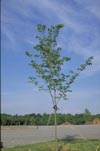Home >
Ulmus americana
'Valley Forge', American Elm
American Elm should be grown in full sun on well-drained, rich soil. If you plant American Elm, plan on implementing a monitoring program to watch for symptoms of Dutch elm disease. It is vital to the health of existing trees that a program be in place to administer special care to these disease-sensitive trees. Some selections, such as this one, are reported to be resistant to the Dutch Elm Disease. In areas such as Texas and Florida where elm populations are less than in northern climates, Dutch elm disease is not likely to be as big a problem as in regions with more elms.
Species occurs naturally in north and central Florida south to Lake Okeechobee.
This cultivar was introduced in 1966 by the National Arboretum and has been tested for disease resistance more than any other cultivar. 'Valley Forge' seems to be more tolerant (96% resistant rate) of Dutch elm disease than 'New Harmony' (86% resistant rate), although both were developed for DED tolerance. These two are probably the best ones to plant in American landscapes since they have received the most testing. 'Princeton' also shows very good resistance to Dutch elm disease. 'Jefferson' and 'Washington' both show promise and have been tested in Washington DC but no where else. 'Valley Forge' may be more cold hardy than indicated, perhaps performing as far north as zone 4.
Trees compartmentalize
decay well. Elms are susceptible to breakage in storms due to frequent
formation of included bark in the unions of main scaffold limbs. Follow
the pruning guidelines below carefully and faithfully. Elms are among
those susceptible to summer branch drop according to surveys in California.
Summer branch drop is a phenomena resulting in failure and breakage of
large diameter, live branches typically on calm summer days. The wood
is considered ring porous which means that there is a large difference
in size between the spring wood pores and the summer wood pores. All elms
reportedly produce allergenic pollen.



